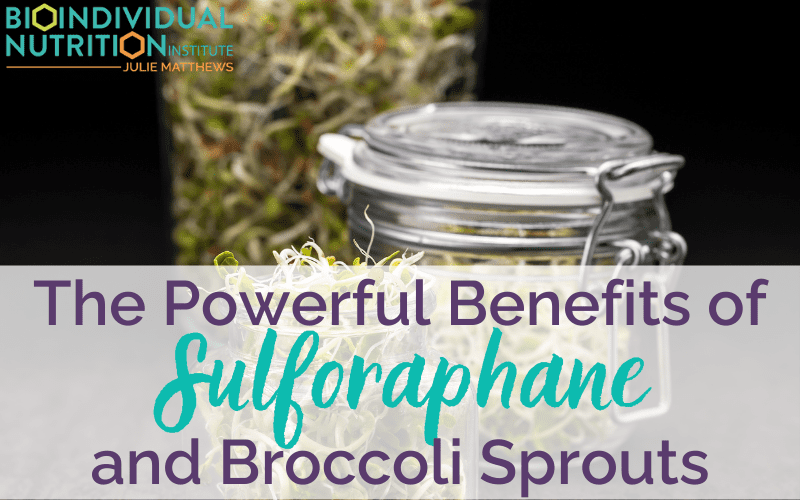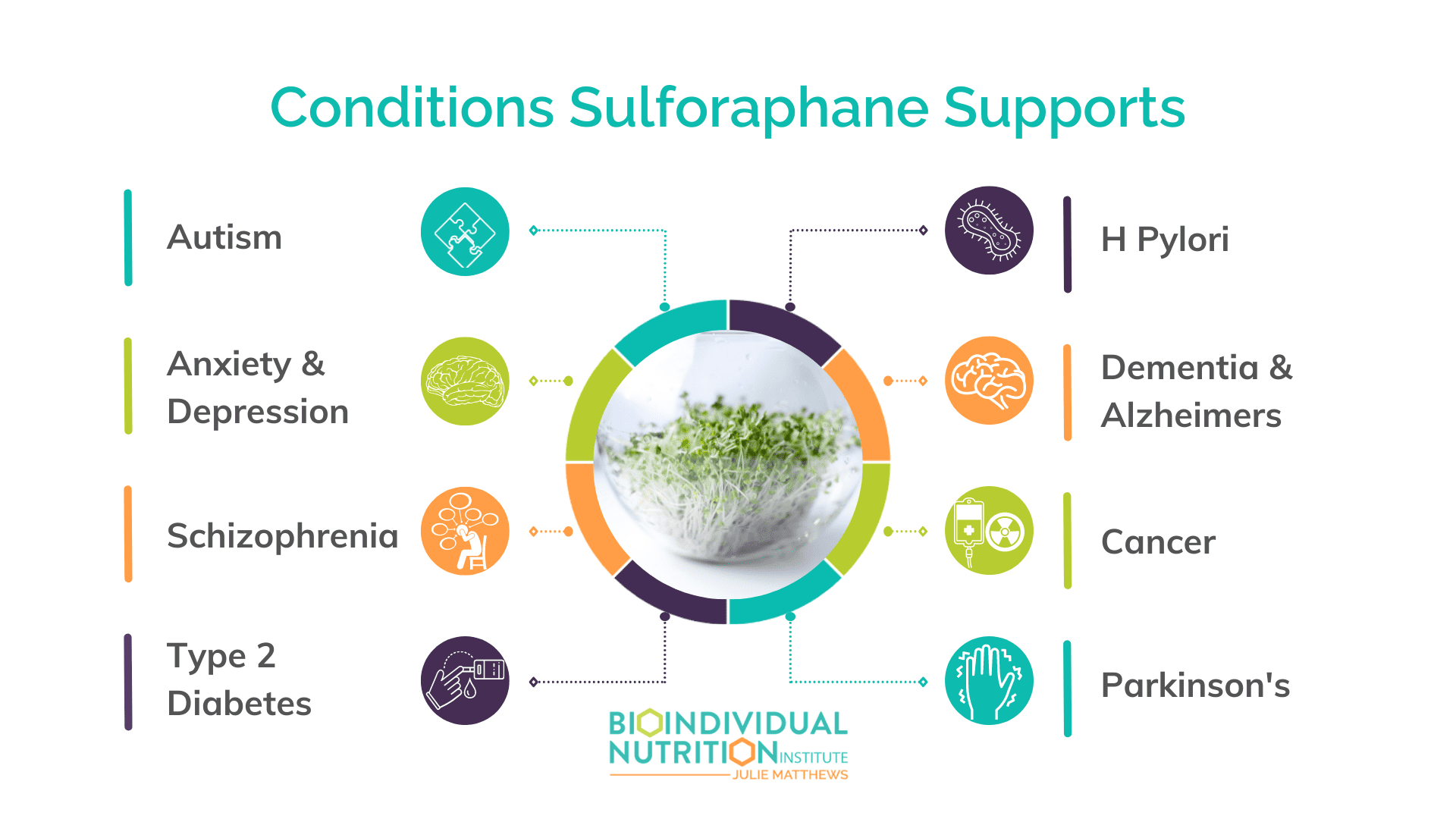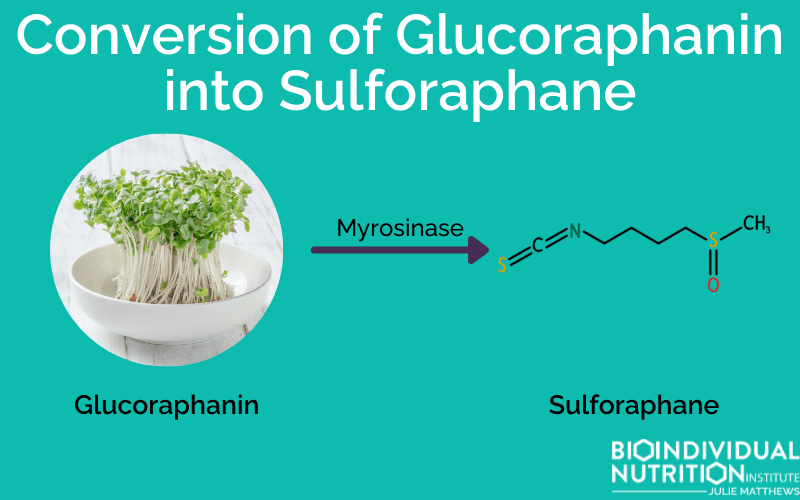
Sulforaphane, the active compound from broccoli sprouts, has many powerful health benefits. Research shows that it is a potent antioxidant and anti-inflammatory substance. It can address neuroinflammation, is neuroprotective, and is even helpful for autism. Sulforaphane is also antimicrobial. It’s cancer protective and has antitumor properties. Furthermore sulforaphane has been shown to support blood sugar regulation.
And, there are supplement options available to consumers that yield sufficient sulforaphane to match the doses used in clinical trials.[1]
Antioxidant, Anti-Inflammatory, and Detoxification
Sulforaphane increases glutathione.[2] Broccoli sprouts contain large amounts of a compound called glucoraphanin, the precursor to sulforaphane. Sulforaphane is a phytochemical that has been known to help increase glutathione production.
Glutathione is the major antioxidant in the body and reduces oxidative stress and inflammation. Sulforaphane was also found to reduce inflammation in the gastrointestinal tract associated with bacterial infection from H. Pylori.[3] Glutathione has even been shown to be protective against the severe inflammation associated with Covid 19.[4] Glutathione also supports a strong immune system and is crucial for the nervous system.
Sulforaphane is very important in detoxification. I’ve written about sulforaphane reducing free radicals associated with pesticide use.
One of the mechanisms by which sulforaphane addresses oxidative stress, inflammation, and detoxification is activation of Nrf2.[5] And sulforaphane has significantly higher bioavailability than polyphenol supplements. Polyphenol bioavailability is less than 10%, whereas sulforaphane bioavailability is 82%.[5]
A study on mice found that sulforaphane upregulated and activated Nrf2 and prevented angiotensin II-induced cardiomyopathy (Angiotensin II is involved in diabetic cardiomyopathy).[6]
Altering Gene Expression
Epigenetics is the study of gene expression, the ability to turn our genes on or off. Toxins can cause epigenetic changes and turning genes detrimental to our health on or off. Many health conditions are, at least in part, due to epigenetic changes. For example, cancer includes many epigenetic alterations that cause tumor growth. Interestingly, sulforaphane has been found to be a dietary epigenetic modulator.[7]
Neuroinflammation and Neuroprotective
 How many of your clients or patients suffer from neuroinflammatory conditions? If you work with individuals with autism and neurodevelopmental conditions, as I do, you may have many clients. Autism as well as Alzheimer’s, dementia, and Parkinson’s are some of the more recognized diagnoses related to neuroinflammation. But, symptoms of neuroinflammation can also include things like chronic pain, fatigue, and depression. That broadens the lens of who may be impacted by neuroinflammation. And research shows that sulforaphane can decrease neuroinflammation.[8]
How many of your clients or patients suffer from neuroinflammatory conditions? If you work with individuals with autism and neurodevelopmental conditions, as I do, you may have many clients. Autism as well as Alzheimer’s, dementia, and Parkinson’s are some of the more recognized diagnoses related to neuroinflammation. But, symptoms of neuroinflammation can also include things like chronic pain, fatigue, and depression. That broadens the lens of who may be impacted by neuroinflammation. And research shows that sulforaphane can decrease neuroinflammation.[8]
Sulforaphane also has neuroprotective benefits. In a study reviewing the neuroprotective effects, researchers highlighted the mechanisms of action of sulforaphane and benefits on various neurological and neurodegenerative conditions including Alzheimer’s, memory, Parkinson’s, psychosis, stroke, epilepsy, toxin exposure, and more.[9]
One way sulforaphane is neuroprotective is that it protects mitochondria, including mitochondrial function in neurons.[9] Through NRF2, sulforaphane protects mitochondrial complex I, II, and IV function, promotes mitochondrial biogenesis, and protects against mitochondrial damage.[9]
Autism and Sulforaphane
Studies show children with autism are low in glutathione.[10] And boosting glutathione supports the underlying systems negatively impacted in autism and can reduce the symptoms of autism.[11] So, this is one mechanism by which broccoli sprouts and sulforaphane can help autism.
Studies on sulforaphane show it improves mitochondrial function and reduces neuroinflammation (two underlying biochemical contributors to the symptoms and severity of autism) and has been shown to improve autism symptoms.[12]
In a follow up paper on these participants, researchers found that because of the beneficial results, many of the participants continued taking the sulforaphane supplement and their reduction in behavioral symptoms of ASD persisted. In fact, their benefits lasted for three years.[13]
In another clinical trial on children with autism they found that sulforaphane supplementation resulted in improvements in both urinary metabolites (biochemical markers of underlying dysfunction) and measures of behavior.[14] They measured behavior via the Aberrant Behavior Checklist (ABC) and Social Responsiveness Scale (SRS) at baseline and at the end of the 12 week study, and the improvements in SRS results were statistically significant. They found changes in 77 metabolites that correlated with improvements in symptoms. These metabolites included markers that indicated:
- Decreases in oxidative stress (often high in children with autism)
- Beneficial changes in amino acids associated with the gut microbiome
- Improvements in neurotransmitters
- Positive changes in hormones including those related to stress
- Changes a type of lipid involved with the myelin sheath in nerves and the brain.
And for a concise look at some of the scientific research, this systematic review on sulforaphane for autism[15] does a great job of going through the literature and distilling down some of the key discussion points via a chart comparing 5 different studies involving autism.
This new research gives us hope and is promising news for autism!
Sulforaphane for Depression and Anxiety
One study found that sulforaphane reduced depressive and anxious behaviors in mice related to stress. “In summary, these findings demonstrated that SFN has antidepressant- and anxiolytic-like [anxiety reducing] activities in stressed mice model of depression, which likely occurs by inhibiting the hypothalamic-pituitary-adrenal (HPA) axis and inflammatory response to stress.”[16]
It was determined via an ELISA analysis that giving sulforaphane actually blocked the increase in the serum levels of corticosterone, adrenocorticotropic hormone, interleukin-6, and tumor necrosis factor in mice that were chronically stressed. How many of your clients are under chronic stress?
Another mouse study also found a reduction in depression-like behaviors with the use of sulforaphane. They concluded “these findings suggest that dietary intake of SFN-rich broccoli sprout has prophylactic effects on inflammation-related depressive symptoms.”[17] The mechanism of action here appears to be on the anti-inflammatory properties of sulforaphane.
Sulforaphane Reduces Glutamate in Schizophrenia
Other studies have shown that sulforaphane may be an effective treatment for a number of mental health disorders including schizophrenia.[18] Sulforaphane may help reduce levels of glutamate, a compound I have talked about quite frequently, which has been linked to disorders like depression and schizophrenia. And in children with autism, glutamate can also be a problematic excitotoxin, which may also be at least one reason why sulforaphane is showing so much promise in this population.
Sulforaphane is Cancer Protective
Many scientific studies have shown that eating cruciferous vegetables such as broccoli, cauliflower, kale, and cabbage either raw or lightly cooked can protect against a number of cancers, and broccoli sprouts have significantly more sulforaphane than cruciferous vegetables. Sulforaphane has been found to slow tumor growth and also stop benign carcinogens from converting into active ones. One study found that 3 to 5 servings of cruciferous vegetables each week reduced cancer risk by up to 40%, and studies on sulforaphane have found it to be chemoprotective and have other health benefits.[19] Having this data to share with clients is helpful for changing dietary behaviors and boosting compliance in my experience.
Sulforaphane is Antimicrobial for H. Pylori
Sulforaphane also helps fight the type of bacteria (H. pylori) that causes ulcers. In fact, one mouse study found that it may even be more effective at treating ulcers than antibiotics when faced with antibiotic-resistant strains and can reduce the risk of associated stomach cancer![20] In another study they correlated these results in both humans and mice as well.[21]
Type 2 Diabetes and Sulforaphane
There is even research looking at the potential for sulforaphane to aid in the reversal of type 2 diabetes. The form of sulforaphane used was a concentrated broccoli sprout extract. The results were that it reduced fasting blood glucose and glycated hemoglobin (HbA1c) in obese patients with dysregulated type 2 diabetes.[22]

Broccoli Sprouts Conversion to Sulforaphane
Broccoli sprouts contain 30 times the amount of sulforaphane precursor as the mature broccoli plant! And as such, broccoli sprouts are by far the best source of sulforaphane. Other cruciferous vegetables and sprouts do not compare to the levels of sulforaphane in broccoli sprouts.
Your clients can get sulforaphane through broccoli sprouts (and can even make their own broccoli sprouts at home) or by taking it in supplement form.
Are all supplements the same? Unfortunately, no, they are not.
Some supplements use ground broccoli seeds and some use powdered broccoli sprouts. They also have different ways of measuring the active ingredient, so products can vary significantly.
Another key component to the potency and efficacy of sulforaphane supplements is an enzyme called myrosinase. Myrosinase is needed to convert sulforaphane glucosinolate into sulforaphane in the small intestine. If a supplement does not contain myrosinase, there could be an issue with conversion into sulforaphane, especially if the individual has GI issues like leaky gut. And I am guessing that many of your clients suffer from gut issues so this can be something important to consider.
One product I have used personally is EnduraCell by Cell-Logic. This product does have myrosinase and is a pure, potent formulation which I get through Doctors Supplement Store – if you do not already have an account and would like one, just email me. The other brand I like and has been used effectively in studies is Avmacol®, which also has myrosinase.

Raw Sprouts Compared with Supplements
Understanding the benefits of sulforaphane and then considering the issues I discussed above (conversion of sulforaphane glucosinolate into sulforaphane), things can get confusing! But, I found a study that was helpful in breaking down this issue so that you can help your clients understand it as well.
Clarke, et al compared plasma and urinary excretion in 12 subjects with 4 subjects in the control group who got alfalfa sprouts and placebo pills. They first gave the test subjects fresh broccoli sprouts, measured their levels and then had a 1 month “washout” period where they were not given the sprouts or a supplement. Then, they gave the subjects 6 pills of a broccoli supplement and once again measured their levels. What they found was exciting to me!
“Although similar doses of glucoraphanin and glucoerucin were given in the sprouts and supplement, the total amounts of SFN and ERN metabolites in the plasma and urine were much lower in the supplement group compared to the sprout group.”[23] The subjects got more sulforaphane out of raw sprouts than the supplement! In another randomized trial, researchers found fresh broccoli sprouts had 5 times the bioavailability as supplements.[24]
But keep in mind, not all supplements are created equally and the supplement used was an inactivated-myrosinase product, so there may be better equivalency depending on the product you use (such as one with myrosinase). And if your clients are eating raw sprouts, they contain myrosinase that’s released through chewing!
So to give you an idea of what that means in terms of quantity of sprouts they would need to eat, the Clarke, et al study used 40 grams of fresh sprouts. That ends up to be about ⅔ of a cup. These were all adult subjects so that gives you an idea of serving size to work from.
The prevailing science seems to point to raw sprouts outperforming supplements, especially if the product does not contain myrosinase. If your clients have the ability to make their own or buy them, that would be great! If you feel like a supplement is more conducive to your clients, then have them look for one that contains myrosinase.
Conclusion
As you can see, sulforaphane is an intriguing compound with a variety of benefits, including general detoxification support which many of our clients (if not all!) can use! As nutrition professionals, you may prefer to get these vital nutrients from food rather than supplements, in which case explaining how to grow your own broccoli sprouts can be a very beneficial thing for your clients.
The continued scientific study on the benefits of sulforaphane is so exciting! One little compound can benefit health and wellness through a variety of mechanisms. And, the great news is that your clients have the power to grow this right at home, without complicated equipment or even much space. But, for those who do prefer a supplement, there are various options to choose from with myrosinase.
If you want to study more about sulforaphane and personalized nutrition topics with us at the BioIndividual Nutrition Institute, here’s more on our training program.
ATTENTION Health Professionals. Download Julie's PDF Guide "8 Clinical Nutrition Cases That Will Change the Way You Practice" to discover how to get breakthrough results using BioIndividual Nutrition.
Your information is safe with us, see our privacy policy.
References
- Houghton, Christine A. “Sulforaphane: its “coming of age” as a clinically relevant nutraceutical in the prevention and treatment of chronic disease.” Oxidative medicine and cellular longevity 2019 (2019).
- Sedlak, Thomas W., Leslie G. Nucifora, Minori Koga, Lindsay S. Shaffer, Cecilia Higgs, Teppei Tanaka, Anna M. Wang et al. “Sulforaphane augments glutathione and influences brain metabolites in human subjects: a clinical pilot study.” Complex Psychiatry 3, no. 4 (2017): 214-222.
- Yanaka, Akinori, Jed W. Fahey, Atsushi Fukumoto, Mari Nakayama, Souta Inoue, Songhua Zhang, Masafumi Tauchi, Hideo Suzuki, Ichinosuke Hyodo, and Masayuki Yamamoto. “Dietary sulforaphane-rich broccoli sprouts reduce colonization and attenuate gastritis in Helicobacter pylori–infected mice and humans.” Cancer Prevention Research 2, no. 4 (2009): 353-360.
- Silvagno, Francesca, Annamaria Vernone, and Gian Piero Pescarmona. “The role of glutathione in protecting against the severe inflammatory response triggered by COVID-19.” Antioxidants 9, no. 7 (2020): 624.
- Houghton, Christine A., Robert G. Fassett, and Jeff S. Coombes. “Sulforaphane and other nutrigenomic Nrf2 activators: can the clinician’s expectation be matched by the reality?.” Oxidative medicine and cellular longevity 2016 (2016).
- Xin, Ying, Yang Bai, Xin Jiang, Shanshan Zhou, Yuehui Wang, Kupper A. Wintergerst, Taixing Cui, Honglei Ji, Yi Tan, and Lu Cai. “Sulforaphane prevents angiotensin II-induced cardiomyopathy by activation of Nrf2 via stimulating the Akt/GSK-3ss/Fyn pathway.” Redox Biology 15 (2018): 405-417.
- Hyun, Tae Kyung. “A recent overview on sulforaphane as a dietary epigenetic modulator.” EXCLI journal 19 (2020): 131-134.
Subedi, Lalita, Jae Hyuk Lee, Bhakta Prasad Gaire, and Sun Yeou Kim. “Sulforaphane inhibits MGO-AGE-mediated neuroinflammation by suppressing NF-κB, MAPK, and AGE–RAGE signaling pathways in microglial cells.” Antioxidants 9, no. 9 (2020): 792. - Klomparens, Eric A., and Yuchuan Ding. “The neuroprotective mechanisms and effects of sulforaphane.” Brain Circulation 5, no. 2 (2019): 74.
- James, S. Jill, Paul Cutler, Stepan Melnyk, Stefanie Jernigan, Laurette Janak, David W. Gaylor, and James A. Neubrander. “Metabolic biomarkers of increased oxidative stress and impaired methylation capacity in children with autism.” The American journal of clinical nutrition 80, no. 6 (2004): 1611-1617.
- Hardan, Antonio Y., Lawrence K. Fung, Robin A. Libove, Tetyana V. Obukhanych, Surekha Nair, Leonore A. Herzenberg, Thomas W. Frazier, and Rabindra Tirouvanziam. “A randomized controlled pilot trial of oral N-acetylcysteine in children with autism.” Biological psychiatry 71, no. 11 (2012): 956-961.
- Singh, Kanwaljit, Susan L. Connors, Eric A. Macklin, Kirby D. Smith, Jed W. Fahey, Paul Talalay, and Andrew W. Zimmerman. “Sulforaphane treatment of autism spectrum disorder (ASD).” Proceedings of the National Academy of Sciences 111, no. 43 (2014): 15550-15555.
- Lynch, Rhoda, Eileen L. Diggins, Susan L. Connors, Andrew W. Zimmerman, Kanwaljit Singh, Hua Liu, Paul Talalay, and Jed W. Fahey. “Sulforaphane from broccoli reduces symptoms of autism: a follow-up case series from a randomized double-blind study.” Global Advances in Health and Medicine 6 (2017): 2164957X17735826.
- Bent, Stephen, Brittany Lawton, Tracy Warren, Felicia Widjaja, Katherine Dang, Jed W. Fahey, Brian Cornblatt, Jason M. Kinchen, Kevin Delucchi, and Robert L. Hendren. “Identification of urinary metabolites that correlate with clinical improvements in children with autism treated with sulforaphane from broccoli.” Molecular autism 9, no. 1 (2018): 1-12.
- McGuinness, Greer, and Yeonsoo Kim. “Sulforaphane treatment for autism spectrum disorder: A systematic review.” EXCLI journal 19 (2020): 892.
- Wu, Shuhui, Qiang Gao, Pei Zhao, Yuan Gao, Yanjie Xi, Xiaoting Wang, Ying Liang, Haishui Shi, and Yuxia Ma. “Sulforaphane produces antidepressant-and anxiolytic-like effects in adult mice.” Behavioural brain research 301 (2016): 55-62.
- Zhang, Ji-chun, Wei Yao, Chao Dong, Chun Yang, Qian Ren, Min Ma, Mei Han et al. “Prophylactic effects of sulforaphane on depression-like behavior and dendritic changes in mice after inflammation.” The Journal of nutritional biochemistry 39 (2017): 134-144.
https://www.hopkinsmedicine.org/news/newsroom/news-releases/broccoli-sprout-compound-may-restore-brain-chemistry-imbalance-linked-to-schizophrenia - Bayat Mokhtari, Reza, Narges Baluch, Tina S. Homayouni, Evgeniya Morgatskaya, Sushil Kumar, Parandis Kazemi, and Herman Yeger. “The role of Sulforaphane in cancer chemoprevention and health benefits: a mini-review.” Journal of cell communication and signaling 12, no. 1 (2018): 91-101.
- Fahey, Jed W., Xavier Haristoy, Patrick M. Dolan, Thomas W. Kensler, Isabelle Scholtus, Katherine K. Stephenson, Paul Talalay, and Alain Lozniewski. “Sulforaphane inhibits extracellular, intracellular, and antibiotic-resistant strains of Helicobacter pylori and prevents benzo [a] pyrene-induced stomach tumors.” Proceedings of the National Academy of Sciences 99, no. 11 (2002): 7610-7615.
- Yanaka, Akinori. “Role of sulforaphane in protection of gastrointestinal tract against H. pylori and NSAID-induced oxidative stress.” Current pharmaceutical design 23, no. 27 (2017): 4066-4075.
Axelsson, Annika S., Emily Tubbs, Brig Mecham, Shaji Chacko, Hannah A. Nenonen, Yunzhao Tang, Jed W. Fahey et al. “Sulforaphane reduces hepatic glucose production and improves glucose control in patients with type 2 diabetes.” Science translational medicine 9, no. 394 (2017): eaah4477. - Clarke, John D., Anna Hsu, Ken Riedl, Deborah Bella, Steven J. Schwartz, Jan F. Stevens, and Emily Ho. “Bioavailability and inter-conversion of sulforaphane and erucin in human subjects consuming broccoli sprouts or broccoli supplement in a cross-over study design.” Pharmacological research 64, no. 5 (2011): 456-463.
- Clarke, John D., Ken Riedl, Deborah Bella, Steven J. Schwartz, Jan F. Stevens, and Emily Ho. “Comparison of isothiocyanate metabolite levels and histone deacetylase activity in human subjects consuming broccoli sprouts or broccoli supplement.” Journal of agricultural and food chemistry 59, no. 20 (2011): 10955-10963.


